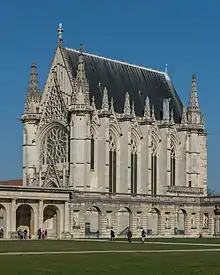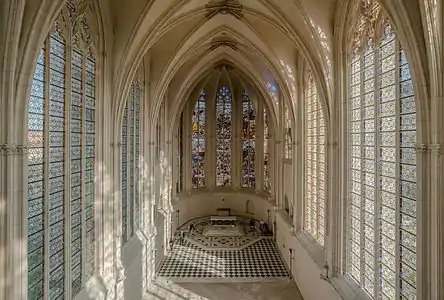Sainte-Chapelle de Vincennes
The Sainte-Chapelle de Vincennes is a Gothic chapel within the fortifications of the château de Vincennes near Paris, France. It was founded in 1379 by Charles V of France to house relics of the passion of Christ. Its design by Raymond du Temple and Pierre de Montereau[1] was based on that of the Sainte-Chapelle in Paris, although the version at Vincennes only had a single level (20m high) compared to the two levels of the Paris version.

On Charles V's death in 1380, work on the chapel continued under his successor Charles VI, under whose rule the choir, the two oratories, the sacristy and the treasury were all completed, with the treasury housing the relics. The nave's construction continued but the works slowed during the Hundred Years War. The facade was only completed in 1480, by Louis XI of France. Under Francis I of France, the ordinary almoner to the king, Guillaume Crétin, also served as the chapel's treasurer, before becoming cantor at the main Sainte-Chapelle in Paris. The interior decoration was only finished under Henry II of France, who in 1551 moved the order of Saint Michael's base from Mont-Saint-Michel to Vincennes. The following year he inaugurated the chapel.
In 1793, during the French Revolution, the interior decoration was destroyed, the stained glass windows smashed and the Baptistery of Saint Louis (long held in the chapel's treasury and used from at least as early as Louis XIII as the baptismal font for children of the French royal family) moved to the Louvre Museum.
The chapel houses the tombs of Bernardin Gigault (who died at Vincennes in 1694) and Louis Antoine, Duke of Enghien. The latter was executed in 1804 in the moat of the Château de Vincennes, near a grave which had already been prepared; in 1816, his remains were exhumed and placed in the chapel.[2]
Gallery
 The west front
The west front The interior of the chapel
The interior of the chapel The rose window as seen from inside
The rose window as seen from inside
References
- "La légende de la Sainte-Chapelle".
- The Duke of Enghien's short biography in Napoleon & Empire website, displaying a photograph of the Duke's private chapel in the Holy Chapel of Vincennes